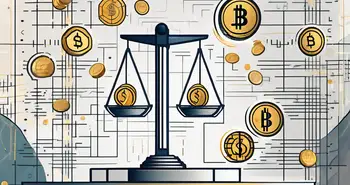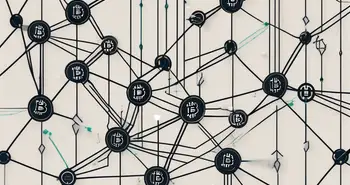The Stablecoin Trilemma: Can Stability, Decentralization, and Scalability Coexist?

Stablecoins have quickly become a hot topic in the world of cryptocurrencies. With their promise of stability, they aim to bridge the gap between the volatile digital assets and the stability of traditional currencies. However, the concept of stablecoins is not without its challenges, and one of the most significant hurdles they face is the so-called Stablecoin Trilemma. In this article, I will guide you through the intricacies of stablecoins and break down the Stablecoin Trilemma to help you understand its impact on the crypto market.
Understanding the Concept of Stablecoin
Before we delve into the Stablecoin Trilemma, let's take a moment to understand what stablecoins are. In essence, stablecoins are cryptocurrencies designed to maintain a stable value by pegging their price to a more stable asset, such as a fiat currency or a commodity like gold. They offer the benefits of cryptocurrencies, such as fast and efficient transactions, while minimizing the volatility associated with traditional cryptocurrencies like Bitcoin or Ethereum.
The Birth of Stablecoin
The idea of stablecoins emerged as a response to the volatility that plagued the crypto market. Bitcoin's wild price swings and other cryptocurrencies' rollercoaster rides made it difficult for individuals and businesses to rely on them as a store of value or a means of exchange. Stablecoins sought to fill this gap by providing a steady digital asset that could be used for everyday transactions.
But where did the concept of stablecoins originate? It can be traced back to the early days of cryptocurrency, when enthusiasts and innovators recognized the need for a more stable form of digital currency. The birth of stablecoins can be seen as a natural evolution of the crypto space, driven by the desire to create a reliable and practical alternative to traditional fiat currencies.
The Purpose and Function of Stablecoin
Stablecoins serve several purposes in the crypto ecosystem. Firstly, they offer a stable medium of exchange that can be used for everyday commerce. This stability makes them attractive for merchants and consumers alike, as they eliminate the uncertainty associated with volatile cryptocurrencies. In addition, stablecoins can also be used as a unit of account and a store of value, further expanding their utility.
Moreover, stablecoins have the potential to bridge the gap between traditional finance and the world of cryptocurrencies. By providing a stable digital asset that can be easily integrated into existing financial systems, stablecoins open up new possibilities for cross-border payments, remittances, and financial inclusion. This has the potential to revolutionize the way we transact and interact with money on a global scale.
Now that we have a clear understanding of stablecoins, let's explore the Stablecoin Trilemma and its implications.
The Stablecoin Trilemma Explained
The Stablecoin Trilemma refers to the three fundamental challenges that stablecoins face in achieving their goals of stability, scalability, and security. These objectives are interconnected, and any attempt to prioritize one pillar often comes at the expense of the others.
Stablecoins have gained significant attention in the world of cryptocurrencies due to their potential to bridge the gap between traditional finance and blockchain technology. By offering a digital asset with a stable value, stablecoins aim to provide a reliable medium of exchange, store of value, and unit of account.
The Three Pillars of the Trilemma
The first pillar of the Stablecoin Trilemma is stability. Stablecoins must maintain a stable value over time to gain trust and widespread adoption. This requires robust mechanisms to ensure that their price remains pegged to the underlying asset, even in times of market stress. The second pillar is scalability, which refers to the ability of stablecoins to handle a large volume of transactions efficiently. Finally, security is crucial to protect stablecoins from hacks, fraud, or any potential vulnerabilities that could compromise their stability.
Ensuring stability in a volatile market is no easy feat. Stablecoin projects often employ various mechanisms such as collateralization, algorithmic adjustments, and governance protocols to maintain the peg to the underlying asset. These mechanisms are continuously tested and refined to withstand market fluctuations and external pressures.
The Interplay of Stability, Scalability, and Security
Balancing stability, scalability, and security is a delicate dance for stablecoin projects. For example, achieving scalability often requires sacrificing some level of decentralization, as centralized solutions can offer faster transaction speed but at the cost of increased risk. Similarly, ensuring the highest level of security may limit the scalability of stablecoins and make them less user-friendly. Striking the right balance among these three pillars is key to the success of stablecoin projects.
Moreover, regulatory challenges add another layer of complexity to the stablecoin ecosystem. Compliance with anti-money laundering (AML) and know your customer (KYC) regulations is essential for stablecoin issuers to operate within the legal framework. Navigating these regulatory requirements while maintaining the core principles of stability, scalability, and security poses a significant challenge for the industry.
The Impact of the Trilemma on the Crypto Market
The Stablecoin Trilemma has wide-ranging implications for both crypto traders and developers. Let's explore these impacts in more detail.
Stablecoins have become an integral part of the cryptocurrency market, offering a bridge between the volatility of traditional cryptocurrencies like Bitcoin and the stability of fiat currencies. The Stablecoin Trilemma, which refers to the challenge of simultaneously achieving stability, scalability, and decentralization in a stablecoin, has sparked intense debates and discussions within the crypto community.
Challenges for Crypto Traders
For crypto traders, the Stablecoin Trilemma introduces additional considerations when choosing stablecoins to use. Traders need to evaluate the stability mechanisms employed by different stablecoin projects and assess the trade-offs between scalability and security. Additionally, the trilemma highlights the importance of diversification, as relying solely on a single stablecoin might expose traders to unnecessary risks.
Moreover, the emergence of new stablecoin models, such as algorithmic stablecoins and commodity-backed stablecoins, adds another layer of complexity for traders. Understanding the underlying mechanisms of these innovative stablecoins is crucial for making informed investment decisions and managing risk effectively in the volatile crypto market.
Implications for Crypto Developers
For crypto developers, the Stablecoin Trilemma poses an ongoing challenge in designing stablecoin protocols. Finding innovative solutions that strike the right balance between stability, scalability, and security is crucial for the success of their projects. This requires continuous research, development, and collaboration with experts from different fields, such as economics and cryptography.
Furthermore, the evolution of regulatory frameworks around stablecoins adds another dimension to the challenges faced by crypto developers. Navigating the complex regulatory landscape while maintaining the core principles of decentralization and privacy is a delicate balance that requires careful consideration and strategic planning.
Possible Solutions to the Stablecoin Trilemma
While the Stablecoin Trilemma presents significant challenges, there are potential solutions that could help mitigate its impact. Let's explore some of these solutions.
Technological Innovations
Advancements in blockchain technology, such as layer 2 scaling solutions and improved smart contract platforms, could offer more efficient and scalable infrastructures for stablecoins. In addition, novel algorithms and consensus mechanisms might enhance the stability and security of stablecoin pegs.
Regulatory Interventions
Regulatory bodies around the world are starting to take notice of stablecoins, as they have the potential to impact financial stability and consumer protection. Regulatory interventions, such as the establishment of clear guidelines and frameworks, can provide stability to the stablecoin ecosystem and foster trust among market participants.
The Future of Stablecoin Amid the Trilemma
As we navigate the Stablecoin Trilemma, the future of stablecoins remains both exciting and uncertain. However, there are predictions and possibilities that we can explore.
Predictions and Possibilities
It is likely that stablecoins will continue to evolve, adapting to the challenges posed by the trilemma. We might witness the emergence of hybrid solutions that combine different types of stablecoins and leverage various technological innovations. Furthermore, stablecoins could play a crucial role in bridging the gap between traditional finance and decentralized finance (DeFi), offering a seamless experience for users.
The Role of Stablecoin in the Evolving Crypto Landscape
Amid the Stablecoin Trilemma, stablecoins have the potential to become a vital component of the ever-evolving crypto landscape. Their ability to provide stability and convenience makes them an attractive option for users seeking a reliable digital asset. As the crypto market matures and stability becomes a paramount concern, stablecoins are well-positioned to play a significant role in reshaping the financial landscape.
FAQ
What are stablecoins?
Stablecoins are cryptocurrencies designed to minimize volatility by pegging their value to a more stable asset, such as a fiat currency or a commodity like gold. They offer stability while retaining the benefits of cryptocurrencies.
What is the Stablecoin Trilemma?
The Stablecoin Trilemma refers to the three challenges of achieving stability, scalability, and security in stablecoin projects. Balancing these pillars is crucial but often poses a trade-off between them.
What are the implications of the Stablecoin Trilemma?
The Stablecoin Trilemma presents challenges for both crypto traders and developers. Traders must consider stability mechanisms and diversification, while developers need to find innovative solutions that balance stability, scalability, and security.
Are there solutions to the Stablecoin Trilemma?
Potential solutions to the Stablecoin Trilemma include technological innovations, such as layer 2 scaling solutions, and regulatory interventions that establish clear guidelines for stablecoin projects.
As you navigate the complexities of the Stablecoin Trilemma, consider the advantages of trading with Morpher. Our revolutionary platform offers a seamless experience that aligns with the stability and innovation stablecoins strive for. With zero fees, infinite liquidity, and the ability to trade a multitude of assets including cryptocurrencies, Morpher is the ideal partner for your trading journey. Embrace the future of investing with our fractional shares, short selling capabilities, and up to 10x leverage. Your safety is paramount, and our non-custodial Morpher Wallet ensures you have full control over your funds. Ready to transform your trading experience? Sign Up and Get Your Free Sign Up Bonus today and join the Morpher community, where investing meets innovation.

Disclaimer: All investments involve risk, and the past performance of a security, industry, sector, market, financial product, trading strategy, or individual’s trading does not guarantee future results or returns. Investors are fully responsible for any investment decisions they make. Such decisions should be based solely on an evaluation of their financial circumstances, investment objectives, risk tolerance, and liquidity needs. This post does not constitute investment advice.

Painless trading for everyone
Hundreds of markets all in one place - Apple, Bitcoin, Gold, Watches, NFTs, Sneakers and so much more.

Painless trading for everyone
Hundreds of markets all in one place - Apple, Bitcoin, Gold, Watches, NFTs, Sneakers and so much more.









